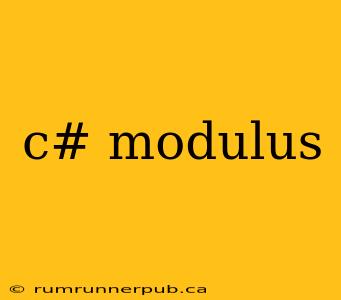The modulus operator (%) in C#, like in many other programming languages, provides the remainder of a division operation. Understanding its behavior is crucial for various programming tasks, from simple data validation to complex algorithms. This article will explore the C# modulus operator through examples, explanations, and insights drawn from Stack Overflow discussions.
The Basics: What is the Modulus Operator?
The modulus operator in C# returns the remainder after an integer division. For example:
10 % 3equals1(10 divided by 3 is 3 with a remainder of 1).15 % 5equals0(15 divided by 5 is 3 with a remainder of 0).-7 % 3equals-1(The sign of the result follows the sign of the dividend in C#).7 % -3equals1
Important Note: The modulus operator works differently for negative numbers compared to some other languages. Understanding this behavior is key to avoiding unexpected results. The sign of the result in C# mirrors the sign of the dividend (the number being divided).
Practical Applications of the Modulus Operator
The modulus operator has numerous applications:
- Even/Odd Number Checks: Determining if a number is even or odd is a classic use case. A number is even if the remainder when divided by 2 is 0.
int number = 10;
if (number % 2 == 0)
{
Console.WriteLine({{content}}quot;{number} is even.");
}
else
{
Console.WriteLine({{content}}quot;{number} is odd.");
}
- Cyclic Operations: The modulus operator is perfect for creating cyclical patterns. For example, you can use it to wrap around an array or list:
int[] array = { 1, 2, 3, 4, 5 };
int index = 10; //Index outside the array bounds
int wrappedIndex = index % array.Length; //wrappedIndex will be 0
Console.WriteLine({{content}}quot;Element at index {index} (wrapped): {array[wrappedIndex]}");
-
Data Validation: Check if a number is divisible by another. For example, you could use it to validate a credit card number's checksum.
-
Time and Date Calculations: Perform calculations involving hours, minutes, and seconds, ensuring you wrap around properly (e.g., calculating the time 5 hours after 22:00).
-
Hashing and Cryptography: Modulus operations are frequently used in hashing algorithms to map large input values to smaller output values.
Addressing Common Stack Overflow Questions
Let's address some common questions found on Stack Overflow concerning the C# modulus operator:
Q1: Why is -7 % 3 equal to -1 in C#?
This behavior is consistent with the C# specification. The sign of the result matches the sign of the dividend. Many other programming languages might produce different results. Understanding this difference is important when porting code or working with libraries written in different languages.
Q2: How can I handle potential division-by-zero errors when using the modulus operator?
Always check for a zero divisor before performing the modulus operation to prevent a DivideByZeroException.
int divisor = 0; //Example of a potential zero divisor
int dividend = 10;
if (divisor != 0) {
int remainder = dividend % divisor;
Console.WriteLine({{content}}quot;The remainder is: {remainder}");
} else {
Console.WriteLine("Error: Cannot divide by zero.");
}
Q3: How to use modulus with floating-point numbers?
While the modulus operator is primarily intended for integer operations, you can use the Math.IEEERemainder() method for floating-point numbers. This method provides a more mathematically precise remainder calculation for floating-point numbers, handling edge cases differently than integer modulus.
double a = 10.5;
double b = 3.2;
double remainder = Math.IEEERemainder(a, b); //More precise remainder calculation.
Console.WriteLine({{content}}quot;The remainder is: {remainder}");
Conclusion
The C# modulus operator is a powerful tool for a wide range of programming tasks. Understanding its behavior, especially with negative numbers, and using appropriate error handling techniques are essential for writing robust and reliable C# applications. By leveraging its capabilities, you can streamline your code and solve complex problems efficiently. Remember to always consult the C# documentation for the most accurate and up-to-date information.
